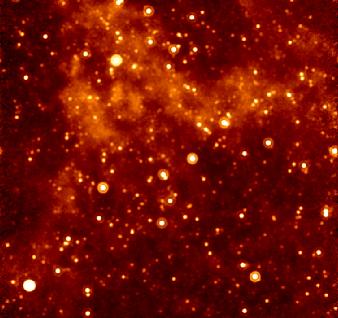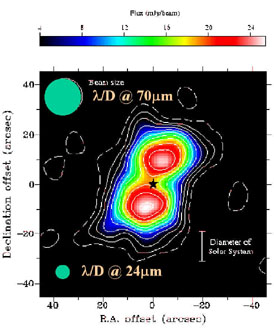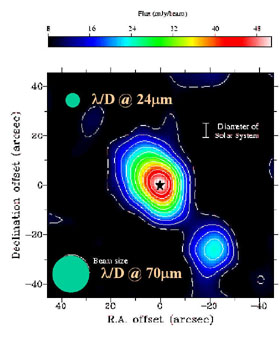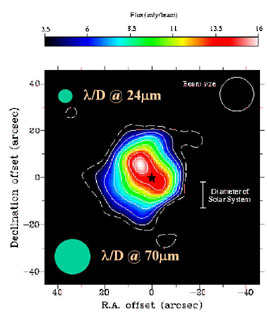 This picture, a part of which you've already
seen, shows how the sky will look to the MIPS 32x32 array. These far
infrared images will detect sources about 100 times fainter than any far infrared surveys
have done before -- that is, prior to SIRTF, the best image we would have of this
simulated field would be nearly empty!. Check this for
comparison with IRAS
(Infrared Astronomical Satellite), ISO (Infrared
Space Observatory), and SOFIA (Stratospheric
Observatory For Infrared Astronomy) images.
This picture, a part of which you've already
seen, shows how the sky will look to the MIPS 32x32 array. These far
infrared images will detect sources about 100 times fainter than any far infrared surveys
have done before -- that is, prior to SIRTF, the best image we would have of this
simulated field would be nearly empty!. Check this for
comparison with IRAS
(Infrared Astronomical Satellite), ISO (Infrared
Space Observatory), and SOFIA (Stratospheric
Observatory For Infrared Astronomy) images.
Such images will show us infrared-bright galaxies to the edge of the known Universe, maybe even farther than any galaxies we have discovered so far. Whenever a galaxy first forms, it has many massive, hot stars. However, these stars live for only a few million years, after which they begin to spew heavy elements out into space -- this spewing reaches a crescendo when the stars explode as supernovae. These heavy elements form dust grains, which in turn are heated by the remaining stars. The dust warms up to only about 60K (about the temperature of liquid air, or Pluto) and hence glows in the far infrared, where MIPS will detect it in images like the one above. In this manner, the far infrared images can lead us back to the moment galaxies first formed and when the heavy elements were produced.
Finding galaxies back when they first formed heavy elements and dust is only one of the projects MIPS could be used for. Another example is to search nearby stars for debris systems that might signal the presence of planets. IRAS (the Infrared Astronomical Satellite, which surveyed the sky in 1983/84) started this field with the discovery of some very dramatic systems such as beta Pictoris, and Vega. We can extend this type of work by measuring the nearest solar-like stars down to the level that corresponds to the wimpy emission we would expect from the solar system itself. In fact, we (Backman, Werner, Rieke, and van Cleve, 1997. ASP Conf., 122, 49) have shown that MIPS, looking back from any close star, could detect the finely divided material we expect lies out in the Kuiper Belt. The KB is the system of small, faint, and very cold objects recently discovered in the solar system outside the orbits of Neptune and Pluto.
The largest aspect of our debris disk program is systematic photometric surveys of large samples of objects. A smaller, but important, part of the program is to image nearby systems. Below, we use the Holland et al. SCUBA images of some systems at 850 microns to show what we can do. The MIPS beam at 70 microns is only slightly larger than the SCUBA one at 850 microns, and at 24 microns the MIPS beam will easily resolve these systems (and others) if they are anywhere near as large as found by SCUBA. Obtaining images at a range of wavelengths lets us determine the structure and composition of the systems, since by thermal equilibrium we expect the cool grains to be farther from the central star, but systems like beta Pic (with a disk more than 10 arcsec in diameter at 10 microns - Pantin, Lagage, & Artymowicz) show that this simple rule is not always correct.

|

|

|
SCUBA images of Fomalhaut (upper left), beta Pic (upper right) and Vega (left), with MIPS beam sizes indicated. |
Another part of our debris disk program is to make large scale, homogeneous maps of star forming regions to inventory systematically their members down to very low luminosities and to catalog the properties of the circumstellar disks. This program would also make use of mid infrared data from IRAC, and of ground based observations in the near infrared. By combining all our data on disks, we hope to document their evolution from Class 1 embedded objects to mature planetary systems.
However, the real breakthroughs are up to the astronomical community. MIPS will detect far infrared sources down to 100 times fainter than we know about now. It will do so with the first areal arrays, allowing 100 times greater efficiency in mapping than any previous experiment (all of which had to make do with small numbers of individual detectors). 80% of the SIRTF time will be used by the general astronomical community, and with such an advance in capability we expect that discoveries will be made well beyond our currently imagined ones.
We will post revisions to our program from time
to time and re-vamping the entire web page soon -- so come visit again in the future!